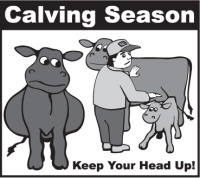



Heads Up – It’s Calving Time
By Kris Ringwall, Beef Specialist, NDSU Extension Service. Checking cows requires an awareness that cows are large, living beings that have a mind of their own.
Despite the strain of checking cows and the aches and pains associated with calving time, spring calving can be a pleasant and rewarding time on any cattle operation. It is more rewarding if one remembers a couple of quick points. The first point is safety and the second is safety.
Have you ever looked into the eye of a cow to find out what is going on inside her mind?
The eyes are large, even pretty and almost provide a reflection of oneself in the moisture that covers the eye. Those bright eyes can be indicative of a bright cow, but do not underestimate what that bright-eyed cow actually is thinking.
Most cows are somewhat passive, used to a producer’s presence and accepting of it. However, mood swings can be wide.
Within a cow/calf herd, two scenarios generally play out. The first would be similar to getting together with a group of friends. As cows associate with people, they accept a certain level of coexistence and don’t mind an occasional visit.
Too much coexistence can create competition that, in some cases, is no different than getting caught between two cows wanting the same bite of food. The small cows usually lose.
If you are checking the cows and are mistaken as the competition, you will be the small one and, if unprepared, you will lose. If you have watched cows co-mingle around a water tank, you may recall two or three cows trying to get a drink of water only to step aside when the boss cows walk up.
In the world of dominance, it is better to be at the top of the pecking order. It is important for cattle to respect you and understand their place.
The most frequent challenge with over-friendly animals is that they catch you off guard, especially when they decide to move up the pecking order. The producer is part of the pecking order, so injuries can happen.
The change in attitude generally happens without warning. It can happen in the middle of a normal day while checking the cows. (A side note: This is one of the reasons when one hears of bulls that challenge their owner; they simply are moving up the pecking order.)
Without re-enforcement, big wins, little loses. On the other extreme, and one that is seldom a surprise, are those cows that are not accustomed to your presence and view the producer as a predator.
These cows (or bulls) display defensive tactics by lifting their head and tail and giving a snort or two and a dance maneuver. These types of cows tend to put everything on the run, including real predators. Some strong arguments can be made for sending these types of cows to the sale barn.
Checking cows requires an awareness that cows are large, living beings that have a mind of their own. While most cows are predictable, the most important point to remember is what is predictable is that cows can be unpredictable.
The unpredictability is intensified by throwing a pinch of hormones into the cycle. Two cases where unpredictability can increase are during calving and breeding. Breeding season is not upon most of us yet, so let’s pass on the bull for now, but calving is under way. Any cow has one priority and that is to nurture and care for the baby to which she just gave birth.
These are not only learned processes, but also the result of physiological changes that occur through pregnancy, calving and post-calving. Cows with newborn calves are unpredictable.
A sudden bellow, a certain smell, the wrong look and the cow has one thing in mind, which is eliminating the problem, but it is not the calf. So heads up in the calving pen and stay safe.


